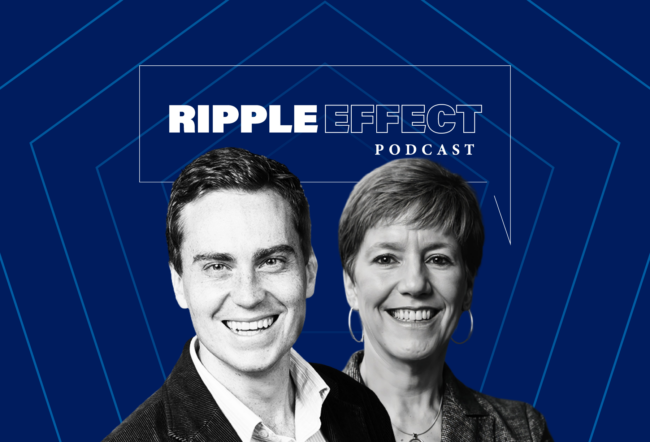Almost every schoolchild knows the basic rules of saving: Put your money in the bank and earn interest, which is paid from what the bank makes by lending the money to someone else. It’s that simple.
At least it has been. Now things are changing, as more central banks are starting to charge institutional depositors instead of paying them. In theory, it’s just another step in efforts to prod economic growth by making borrowing cheap, or encouraging those with cash to use it rather than store it. But “negative” interest rates are something of an unknown quantity, making many wonder if the policy could backfire.
“I’m concerned,” says Olivia S. Mitchell, professor of business economics and public policy at Wharton, describing the uncertainty. “We’ve been used to an environment where you take a dollar to the bank and you get the dollar back,” she adds. “With this new negative interest approach, you are going to be charged a fee.”
“I think it definitely should be considered if the economy is slow and you’ve run out of ways to stimulate,” says Wharton finance professor Itay Goldstein. “But I am somewhat skeptical that it’s going to be that effective.”
In 2014, the European Central Bank became the first major central bank to adopt a negative interest rate policy. In December, it again dropped its rate, charged on cash it holds overnight for financial institutions, to -0.3%. Sweden, Denmark and Switzerland also use negative rates. In fact, at the end of 2015, about a third of all debt issued by eurozone governments had negative yields, according to a Bloomberg analysis.
“I think it definitely should be considered if the economy is slow and you’ve run out of ways to stimulate. But I am somewhat skeptical that it’s going to be that effective.” –Itay Goldstein
Then, at the end of January, the Bank of Japan announced that it, too, was going to implement negative rates. And at about the same time, U.S. Federal Reserve Chair Janet Yellen said the Fed was studying the possibility, though she did not indicate it would go negative anytime soon.
‘A Sign of Desperation’
“Negative rates are a sign of desperation, a signal that traditional policy options have proved ineffective and new limits need to be explored,” the Bloomberg analysis said. “They punish banks that hoard cash instead of extending loans to businesses or to weaker lenders. Rates below zero have never been used before in an economy as large as the euro area.”
In other words, there’s not much history to indicate what will happen.
Negative rates are intended to produce an incentive to spend rather than save, and spending should help fire the economy and push prices up. Europe and Japan have resorted to negative rates to reduce the risk of deflation, which has many damaging effects such as making debt payments more burdensome over time.
Central banks have direct control only over short-term rates, such as those charged to financial institutions that keep overnight deposits on central bank books. But trimming short-term rates tends to ripple through the economy, causing a drop in long-term rates that are governed by supply and demand. In part, that’s because long-term rates on things like bonds or mortgages are based on views of what short-term rates will be in the future.
“Once you start affecting the cost of capital for banks, then this will affect the market price of assets they buy and the loans they make,” Goldstein says.
Lower interest rates also tend to reduce a currency’s value, since savers’ demand will drop as they shift to better-paying investments in other currencies. A devalued currency can boost exports and it can raise inflation by making imports more expensive. Japan’s turn to negative rates was largely an effort to devalue the yen — although it seems to be backfiring.
In practical terms, a slightly negative rate is not much different from the slightly positive rates that short-term savings have earned for years. After all, earning 0.1% is not much better than losing 0.1%. And after accounting for inflation — reflected in the so-called real interest rate — savers actually have been losing money for years.
Even if rates go negative, there remains an incentive to save if a bank, money market fund or short-term bond keeps your money safer than a stock, long-term bond or other asset. Short-term savings also are easily accessible when needed. So a saver weighing the alternatives might shrug off a negative rate — as long as it’s not too negative. But that’s not to say the situation is painless.
“I’m not sure there is much difference between the 0.1% we’ve been earning for the last few years on money market funds and the -0.2% we might earn in a negative interest world.” –Richard Marston
The effect of going negative “absolutely depends on how negative it gets,” says Mitchell. “The problem is that if there’s inflation, the cost of living is going up…. It’s already been very difficult for people like my mother, who laddered her CDs and was just trying to live on her interest and not pull down principal. The last eight years have been difficult” for people on fixed incomes.
Back to Mattresses
Some predict that negative rates — if passed on to ordinary bank customers — will cause businesses and the public to just stop using traditional savings. “I think the concern is that eventually people will just not put their money in the bank,” Goldstein says. “They will just store it. They will put it in the mattress.”
In ordinary times, savers use banks and other short-term cash vehicles even though inflation erodes savings’ value, because inflation will do its damage even if cash is stuffed in a mattress, Goldstein points out. But the effect of a negative rate can be avoided by using a mattress or some other strategy that does not involve a charge on savings, he adds.
“Once the nominal [or stated] interest rate is going to be negative, there is going to be an additional loss that you incur by putting money into the bank,” he says. Central banks going negative are, in effect, probing to “figure out what is the lower bound” — the point where savers decide that saving has too little upside.
“There is an actual storage cost — some cost of dealing with not putting money into the bank,” Goldstein says. Shifting to gold, for instance, would require renting or buying a vault. So even if banks charge for savings, a bank could still be better than the alternative, up to a point. “There still will be a lower bound. You cannot go negative 10%,” he notes.
“If they lower the interest rate enough, then you will start spending” instead of saving, Goldstein explains. “[People] can invest in real estate. They can put it into a stock, put it into a bond. They can start a business…. With most of those things, the hope is that they are going to stimulate the economy.”
That’s a good thing, right? Isn’t the point of a negative rate to get those with cash to put it to work — building new factories, hiring workers, spending on goods and services or investing in companies?
It’s good if the theory holds up, but there’s too little experience to know that it will. According to Christopher Swann, a strategist at UBS Wealth Management, the strategy could backfire if it cuts bank profits by narrowing the difference between the rates banks charge borrowers and the rates banks pay to get cash for loans. “If profits suffer too much, banks may even scale back lending,” he wrote in a February report.
Also, it is not clear negative rates could push investors from bonds to stocks, lifting equity indices. Indeed, the narrowing of bank profitability could actually hurt stocks because banks such as those in the U.S. and Japan comprise a “large proportion of equity market capitalization,” Swann said.
“I think it’s a big mess in the making.” –Olivia S. Mitchell
Another concern is how negative interest, if it becomes widespread, might affect inflation. If money is losing value, it’s less likely that consumers and businesses will bid up prices for goods, services and labor. That could trigger deflation, which has the perverse effect of discouraging spending, exactly the opposite of what the negative interest rate policy is intended to do. In deflationary times, economies whither.
No Magic Bullet
So, will negative rates stimulate economies as intended, or have some perverse unintended consequence?
“It’s hard to say,” Goldstein says. “At the end of the day, monetary policy is limited in what it can achieve.” Central banks have kept interest rates at historical lows for years and growth has remained sluggish anyway. “It’s effective to some degree, but it’s not a magic bullet.”
He continues: “This is why [monetary policy] is not the only tool you have. You also [have to] think about fiscal policy — for example, creating a more convenient business environment, reducing regulation” and other moves.
In the worst-case scenario, says Goldstein, an easy-money policy can create an asset bubble by making it easier to bid up prices for things like homes or commodities. “That doesn’t really stimulate the economy,” he notes. It would spur inflation, but by too much.
How would negative rates affect ordinary investors’ decisions on matters like dividing a portfolio between stocks, bonds and cash?
“Regarding asset allocation, I’m not sure there is much difference between the 0.1% we’ve been earning for the last few years on money market funds and the -0.2% we might earn in a negative interest world,” says Wharton finance professor Richard Marston. It’s not certain, he adds, that banks would actually pass on to customers the slightly higher costs of interbank deposits.
It’s uncharted territory, Mitchell says, worrying about the possibility of unwelcome outcomes like bank runs. “I think it’s a big mess in the making.”



